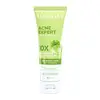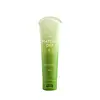What's inside
What's inside
 Key Ingredients
Key Ingredients

 Benefits
Benefits

 Concerns
Concerns

 Ingredients Side-by-side
Ingredients Side-by-side

Water
Skin ConditioningGlycerin
HumectantSodium Cocoyl Glycinate
CleansingDisodium Cocoyl Glutamate
CleansingButylene Glycol
HumectantBetaine
HumectantLauramidopropyl Betaine
CleansingHydroxypropyl Starch Phosphate
Niacinamide
SmoothingCitric Acid
BufferingSodium Chloride
MaskingTocopheryl Acetate
AntioxidantZinc PCA
HumectantCentella Asiatica Extract
CleansingPEG-6 Almond Glycerides
EmollientPropylene Glycol
HumectantCaprylyl Glycol
EmollientAllantoin
Skin ConditioningPanthenol
Skin ConditioningDisodium EDTA
Melaleuca Alternifolia Leaf Oil
AntioxidantPEG-20
HumectantEthylhexylglycerin
Skin ConditioningCaprylic/Capric Triglyceride
MaskingAscorbic Acid
AntioxidantCarbomer
Emulsion StabilisingNordihydroguaiaretic Acid
AntioxidantOleanolic Acid
Skin ConditioningWater, Glycerin, Sodium Cocoyl Glycinate, Disodium Cocoyl Glutamate, Butylene Glycol, Betaine, Lauramidopropyl Betaine, Hydroxypropyl Starch Phosphate, Niacinamide, Citric Acid, Sodium Chloride, Tocopheryl Acetate, Zinc PCA, Centella Asiatica Extract, PEG-6 Almond Glycerides, Propylene Glycol, Caprylyl Glycol, Allantoin, Panthenol, Disodium EDTA, Melaleuca Alternifolia Leaf Oil, PEG-20, Ethylhexylglycerin, Caprylic/Capric Triglyceride, Ascorbic Acid, Carbomer, Nordihydroguaiaretic Acid, Oleanolic Acid
Water
Skin ConditioningPotassium Cocoyl Hydrolyzed Collagen
Skin ConditioningGlycerin
HumectantAcrylates Copolymer
Cocamidopropyl Betaine
CleansingPotassium Cocoyl Glycinate
Butylene Glycol
HumectantDecyl Glucoside
CleansingPEG-120 Methyl Glucose Dioleate
EmulsifyingPentylene Glycol
Skin ConditioningXanthan Gum
EmulsifyingAvena Sativa Kernel Extract
AbrasivePanthenol
Skin ConditioningGlycyrrhiza Glabra Leaf Extract
Skin ConditioningTriethanolamine
BufferingClitoria Ternatea Flower Extract
Skin Conditioning1,2-Hexanediol
Skin ConditioningHouttuynia Cordata Extract
Skin ConditioningSodium Hyaluronate
HumectantEthylhexylglycerin
Skin ConditioningCinnamomum Zeylanicum Bark Extract
AntimicrobialCapryloyl Glycine
CleansingSarcosine
Skin ConditioningCitrus Junos Seed Extract
AntioxidantCitrus Unshiu Peel Extract
MaskingActinidia Chinensis Seed
AbrasiveSalicylic Acid 0.01%
MaskingFragaria Chiloensis Fruit Extract
Skin ConditioningVitis Vinifera Seed Extract
AntimicrobialVitis Vinifera Skin Extract
AntioxidantVitis Vinifera Leaf Extract
Skin ConditioningGarcinia Mangostana Peel Extract
Skin ConditioningPropanediol
SolventSodium Hydroxide
BufferingDipotassium Glycyrrhizate
HumectantChlorphenesin
AntimicrobialAllantoin
Skin ConditioningDisodium EDTA
Camellia Sinensis Leaf
PerfumingWater, Potassium Cocoyl Hydrolyzed Collagen, Glycerin, Acrylates Copolymer, Cocamidopropyl Betaine, Potassium Cocoyl Glycinate, Butylene Glycol, Decyl Glucoside, PEG-120 Methyl Glucose Dioleate, Pentylene Glycol, Xanthan Gum, Avena Sativa Kernel Extract, Panthenol, Glycyrrhiza Glabra Leaf Extract, Triethanolamine, Clitoria Ternatea Flower Extract, 1,2-Hexanediol, Houttuynia Cordata Extract, Sodium Hyaluronate, Ethylhexylglycerin, Cinnamomum Zeylanicum Bark Extract, Capryloyl Glycine, Sarcosine, Citrus Junos Seed Extract, Citrus Unshiu Peel Extract, Actinidia Chinensis Seed, Salicylic Acid 0.01%, Fragaria Chiloensis Fruit Extract, Vitis Vinifera Seed Extract, Vitis Vinifera Skin Extract, Vitis Vinifera Leaf Extract, Garcinia Mangostana Peel Extract, Propanediol, Sodium Hydroxide, Dipotassium Glycyrrhizate, Chlorphenesin, Allantoin, Disodium EDTA, Camellia Sinensis Leaf
Ingredients Explained
These ingredients are found in both products.
Ingredients higher up in an ingredient list are typically present in a larger amount.
Allantoin is a soothing ingredient known for its protective and moisturizingg properties. Because of this, it is often added to products with strong active ingredients.
Studies show higher concentrations of this ingredient can promote wound healing.
Though it can be derived from the comfrey plant, allantoin is produced synthetically for cosmetic products to ensure purity.
Learn more about AllantoinButylene Glycol (or BG) is used within cosmetic products for a few different reasons:
Overall, Butylene Glycol is a safe and well-rounded ingredient that works well with other ingredients.
Though this ingredient works well with most skin types, some people with sensitive skin may experience a reaction such as allergic rashes, closed comedones, or itchiness.
Learn more about Butylene GlycolDisodium EDTA plays a role in making products more stable by aiding other preservatives.
It is a chelating agent, meaning it neutralizes metal ions that may be found in a product.
Disodium EDTA is a salt of edetic acid and is found to be safe in cosmetic ingredients.
Learn more about Disodium EDTAEthylhexylglycerin (we can't pronounce this either) is commonly used as a preservative and skin softener. It is derived from glyceryl.
You might see Ethylhexylglycerin often paired with other preservatives such as phenoxyethanol. Ethylhexylglycerin has been found to increase the effectiveness of these other preservatives.
Glycerin is already naturally found in your skin. It helps moisturize and protect your skin.
A study from 2016 found glycerin to be more effective as a humectant than AHAs and hyaluronic acid.
As a humectant, it helps the skin stay hydrated by pulling moisture to your skin. The low molecular weight of glycerin allows it to pull moisture into the deeper layers of your skin.
Hydrated skin improves your skin barrier; Your skin barrier helps protect against irritants and bacteria.
Glycerin has also been found to have antimicrobial and antiviral properties. Due to these properties, glycerin is often used in wound and burn treatments.
In cosmetics, glycerin is usually derived from plants such as soybean or palm. However, it can also be sourced from animals, such as tallow or animal fat.
This ingredient is organic, colorless, odorless, and non-toxic.
Glycerin is the name for this ingredient in American English. British English uses Glycerol/Glycerine.
Learn more about GlycerinPanthenol is a common ingredient that helps hydrate and soothe the skin. It is found naturally in our skin and hair.
There are two forms of panthenol: D and L.
D-panthenol is also known as dexpanthenol. Most cosmetics use dexpanthenol or a mixture of D and L-panthenol.
Panthenol is famous due to its ability to go deeper into the skin's layers. Using this ingredient has numerous pros (and no cons):
Like hyaluronic acid, panthenol is a humectant. Humectants are able to bind and hold large amounts of water to keep skin hydrated.
This ingredient works well for wound healing. It works by increasing tissue in the wound and helps close open wounds.
Once oxidized, panthenol converts to pantothenic acid. Panthothenic acid is found in all living cells.
This ingredient is also referred to as pro-vitamin B5.
Learn more about PanthenolWater. It's the most common cosmetic ingredient of all. You'll usually see it at the top of ingredient lists, meaning that it makes up the largest part of the product.
So why is it so popular? Water most often acts as a solvent - this means that it helps dissolve other ingredients into the formulation.
You'll also recognize water as that liquid we all need to stay alive. If you see this, drink a glass of water. Stay hydrated!
Learn more about Water